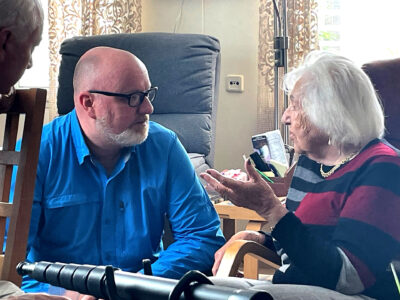 We expected this visit to be something special, and we were right.
We expected this visit to be something special, and we were right.
We drove to the Kibbuts Givat Oz, where we were immediately and warmly welcomed by Hanan Tzur, the son of the remarkable woman we came to see. The kibbutz itself is modest to say the least, but her corner of it is a veritable Eden thanks to the variety and vitality of the plants and trees she has nurtured all around her home.
 In 1943, when she was a young girl named Aliza Melamed, she passed secret messages throughout the Warsaw Ghetto, plans for the uprising many of the imprisoned Jews were planning. If she had been discovered doing this, the Nazis would certainly have killed her on the spot as an example to others. But she was as brave as she was stealthy — so undeterred by the threat of death, she conveyed countless messages and plans that were vital to the rebellion.
In 1943, when she was a young girl named Aliza Melamed, she passed secret messages throughout the Warsaw Ghetto, plans for the uprising many of the imprisoned Jews were planning. If she had been discovered doing this, the Nazis would certainly have killed her on the spot as an example to others. But she was as brave as she was stealthy — so undeterred by the threat of death, she conveyed countless messages and plans that were vital to the rebellion.
A recent CNN piece about her said she, her sister, and their mother “were eventually captured and sent to Bergen-Belsen – where they remained until US forces liberated the camp at the end of the war.”
And the gist of that statement is correct except (a) the British liberated Bergen-Belsen and (b) Aliza wasn’t there when it happened because she was one of the 2,500 people sent away on the train nine days earlier — the train that would be liberated on April 13.
So Aliza, now called Aliza Vitis-Shomron, has today the dual distinction of being one of the survivors of the ‘train near Magdeburg,” and the last survivor of the Warsaw Ghetto Uprising.
 While Joe and Josh set up the camera and lights, she clipped a pin to her blouse — her 95-year-old fingers having a little difficulty with the tiny clasp — and she told me (in Hebrew) what it signified.
While Joe and Josh set up the camera and lights, she clipped a pin to her blouse — her 95-year-old fingers having a little difficulty with the tiny clasp — and she told me (in Hebrew) what it signified.
I didn’t understand.
Her translator said, with a broad smile, “Yes — her special award for Valor Against Fascism. This was given to her by Israeli President Shimon Peres.”
She was eager to show Matt Rozell photographs from the 1940s — people she knew from the Warsaw Ghetto. Some escaped but have long since died. Some were killed by the Nazis in the uprising.

Just three days before we arrived, CNN News had honored Aliza with an interview and article as part of their observance of Holocaust Remembrance Day. You can see it all here.
 The CNN piece was certainly not the first time she has spoken before immense audiences! Aliza has filled her life with opportunities to tell her story. This photo, for example, shows her speaking at Yad Vashem in 2013, at an event marking the 70th anniversary of the Warsaw Ghetto Uprising.
The CNN piece was certainly not the first time she has spoken before immense audiences! Aliza has filled her life with opportunities to tell her story. This photo, for example, shows her speaking at Yad Vashem in 2013, at an event marking the 70th anniversary of the Warsaw Ghetto Uprising.
Shortly before the uprising, she was urged by the members of the insurrection to escape before the fighting began — so in the worst case scenario at least someone would survive to tell their story. Aliza’s gripping memoir Youth in Flames is her fulfillment of that sacred duty.
The CNN interview gave her a chance to emphasize one of her most important messages:
“It is important for me to tell the story, not so much my story, but how we fought bravely. If we don’t tell the world how we Jews fought, the world will only look at us as victims who went like lambs to the slaughter.”
Aliza adds, “But we did fight and we did it in so many different ways. We need to tell people the truth.”
 The highlight of the visit for me — maybe for everyone there — was at the end of our interview recording. She spoke of her fears for the future, about the dwindling number of eyewitnesses who can tell the truth, who can carry forward the testimony of those who barely escaped, let alone those who were murdered by the Nazis.
The highlight of the visit for me — maybe for everyone there — was at the end of our interview recording. She spoke of her fears for the future, about the dwindling number of eyewitnesses who can tell the truth, who can carry forward the testimony of those who barely escaped, let alone those who were murdered by the Nazis.
“Who will keep my story alive?” she asked.
And Mike Edwards said, quietly but firmly, “We will.”
He offered his hand and she reached out to take it.
And, smiling through tears, she held it for a long time.